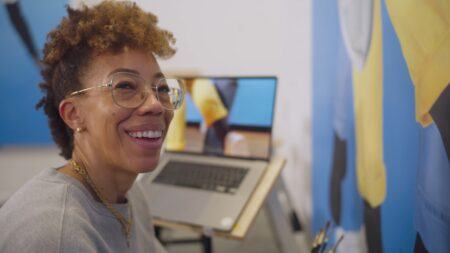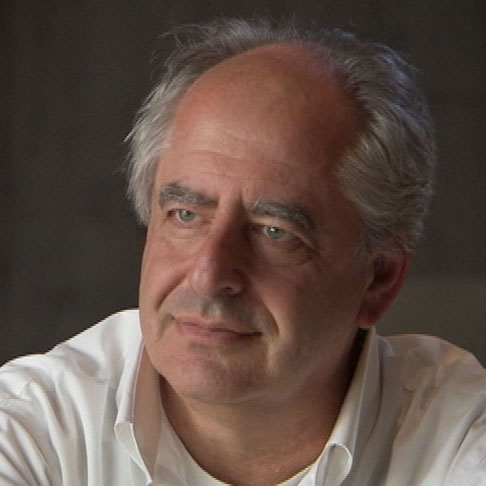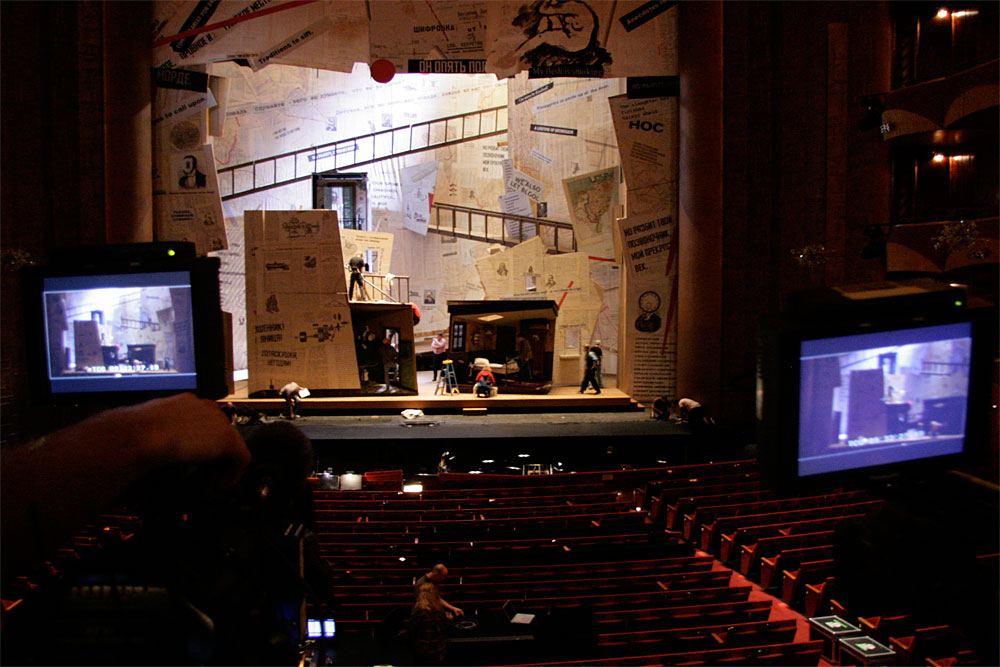Continue playing
(Time remaining: )
Play from beginning
Continue playing "{{ controller.videos[controller.getVideo(controller.currentVideo)].segmentParentTitle}}"
{{controller.videos[controller.getVideo(controller.currentVideo)].title}} has ended.
William Kentridge: Anything Is Possible
Visit our Awards page for this film’s honors and recognition.
William Kentridge: Anything Is Possible gives viewers an intimate look into the mind and creative process of William Kentridge, the South African artist whose acclaimed charcoal drawings, animations, video installations, shadow plays, mechanical puppets, tapestries, sculptures, live performance pieces, and operas have made him one of the most dynamic and exciting contemporary artists working today. With its rich historical references and undertones of political and social commentary, Kentridge’s work has earned him inclusion in Time magazine’s 2009 list of the 100 most influential people in the world.
This documentary features exclusive interviews with Kentridge as he works in his studio and discusses his artistic philosophy and techniques. In the film, Kentridge talks about how his personal history as a white South African of Jewish heritage has informed recurring themes in his work—including violent oppression, class struggle, and social and political hierarchies. Additionally, Kentridge discusses his experiments with “machines that tell you what it is to look” and how the very mechanism of vision is a metaphor for “the agency we have, whether we like it or not, to make sense of the world.” We see Kentridge in his studio as he creates animations, music, video, and projection pieces for his various projects, including Breathe (2008); I am not me, the horse is not mine (2008); and the opera The Nose (2010), which premiered earlier this year at New York’s Metropolitan Opera to rave reviews.
With its playful bending of reality and observations on hierarchical systems, the world of The Nose provides an ideal vehicle for Kentridge. The absurdism, he explains in the documentary’s closing, “…is in fact an accurate and a productive way of understanding the world. Why should we be interested in a clearly impossible story? Because, as Gogol says, in fact the impossible is what happens all the time.”
More information and creditsCredits
Executive Producer and Director: Susan Sollins. Director: Charles Atlas. Editor: Mark Sutton & Mary Ann Toman. Co-Producer: Eve Moros Ortega. Director of Production: Nick Ravich. Production Coordinator: Ian Forster & Larissa Nikola-Lisa.
Artworks Courtesy of: William Kentridge & Marian Goodman Gallery.
William Kentridge films: Breathe; Johannesburg, 2nd Greatest City after Paris; 7 Fragments for Georges Méliès; Shadow Procession; Sobriety, Obesity & Growing Old; Ubu Tells the Truth; & What Will Come (has already come). Editing by Catherine Meyburgh. Original Music by Philip Miller.
On Screen Participants (in order of appearance): Nokrismesi “Kimmy” Skota, Philip Miller, Samuel Kentridge, Treasure Zulu, Anne Stanwix, Alice Kentridge, Isabella Kentridge, Paulo Szot, & Alfred Makgalemele.
Director of Photography: Bob Elfstrom & Joel Shapiro. Additional Photography: Jarred Alterman, Philippe Charluet, & Clair Popkin. Sound: Tom Bergin, Ray Day, Justin Matley, Patrick Mullins, Roger Phenix, Mark Roy, & Merce Williams. Assistant Camera: Greg Bigelow, Craig Feldman, & Sara C. Hahn. Assistant Sound: Nicholas Lindner. Production Assistant: Jimmy Chauke. Online Editor: Don Wyllie.
Design: Open. Voiceover Artist: Jace Alexander. Sound Edit & Mix: Cory Melious. Assistant Sound Edit: Steve “Major” Giammaria. Assistant Editor: Ahmed Amer, Paulo Padilha, Joaquin Perez, Leana Siochi, & Ken Yapelli. <i>The Nose</i> Music Courtesy of: DIE NASE; Dmitri Schostakowitsch; & With kind permission of Universal Edition AG, Wien.
Archival Footage Courtesy of: Handspring Puppet Company, Johannesburg; kunstenFESTIVAL des Arts, Brussels; Mann Made Media; Philippe Pierlot; Ricercar Consort; Rundfunk Berlin-Brandenburg; Wiener Festwochen; & La Monnaie/De Munt.
Special Thanks: William Kentridge Studio; Marian Goodman Gallery, New York & Paris; Goodman Gallery, Johannesburg; The Metropolitan Opera; The Museum of Modern Art; Lee Abrahamian; Beth Allen; Annandale Galleries, Sydney; Art21 Board of Trustees; Art21 Producers Circle; Mark Ashkinos; The Biennale of Sydney; Mia Bongiovanni; Travis Call; Peter Clark; Lisa Cloete; Ralph Cuccurullo; Natalie Dembo; Alexandra Eastman; Liza Essers; Peter Gelb; Valery Gergiev; Isabella Hangel; Judy Hecker; Barbara Gundlach; Kim Gunning; Paul Jackson; James Cohan Gallery; James Kendrick; The Kentridge Family; Linda Leibowitz; Hilary Ley; Sheila Lynch; Anne McIlleron; Dr. Reiner Moritz; Elena Park; Katherine Payne; Performa; Jim Powell; The San Francisco Museum of Modern Art; François Sarhan; Keith Shapiro; Pavel Smelkov; Marybeth Sollins; Sound Lounge; Stephens Tapestry Studio; Sydney Harbour Federation Trust; Catherine Tatge; Sabine Theunissen; Steve Wylie; & Patrick Young.
Additional Art21 Staff: Joe Fusaro, Jessica Hamlin, Marc Mayer, Wesley Miller, Jonathan Munar, Heather Reyes, Kelly Shindler, Sara Simonson, & Diane Vivona. Curatorial Assistants: Mary Cook & Jennifer Lee. Junior Designer: Daniel Barrett. Interns: Daniel Atkinson, Travis Fitzgerald, Sophie Grant, Jessica Kingdon, Melanie K. Mambo, Sara Odam, Poukhan Philavanh, Ada Potter, Nicole Sansone, & Marianna Siciliano.
Public Relations: DKC Public Relations. Station Relations: De Shields Associates, Inc. Legal Counsel: Albert Gottesman.
Major underwriting for William Kentridge: Anything Is Possible and its accompanying education programs provided by: The Anna-Maria and Stephen Kellen Foundation; Agnes Gund; The Brenda R. Potter and Michael C. Sandler Charitable Foundation; The Broad Art Foundation; The Horace W. Goldsmith Foundation; Toby Devan Lewis; The National Endowment for the Arts; Marian Goodman Gallery; Goodman Gallery, Johannesburg; Barbara and Andrew Gundlach; Lew and Susan Manilow; Thomas A. and Georgina T. Russo; Louise Eliasof and James Sollins; Nina and Michael Sundell; Nina and Michael Zilkha; & Individual contributions to Art21.
Closed captionsAvailable in English, German, Romanian, Italian, Japanese, Korean, Chinese, Italian
Through the Art21 Translation Project, multilingual audiences from around the globe can contribute translations, making Art21 films more accessible worldwide.
Interested in showing this film in an exhibition or public screening? To license this video please visit Licensing & Reproduction.
Having witnessed first-hand one of the twentieth century’s most contentious struggles—the dissolution of apartheid—William Kentridge brings the ambiguity and subtlety of personal experience to public subjects that are most often framed in narrowly defined terms. Using film, drawing, sculpture, animation, and performance, he transmutes sobering political events into powerful poetic allegories. In a now-signature technique, Kentridge photographs his charcoal drawings and paper collages over time, recording scenes as they evolve.
“The belief in the opera…has to do strongly with the belief that the absurd, with its rupture of rationality—of conventional ways of seeing the world—is in fact an accurate and a productive way of understanding the world.”
William Kentridge
The Making of "William Kentridge: Anything Is Possible"
Producers Eve Moros Ortega and Nick Ravich sat down for a casual conversation about the production of William Kentridge: Anything Is Possible.
William Kentridge
William Kentridge




